The Economics and Statistics Division maintains archives of previous publications for accountability purposes, but makes no updates to keep these documents current with the latest data revisions from Statistics Canada. As a result, information in older documents may not be accurate. Please exercise caution when referring to older documents. For the latest information and historical data, please contact the individual listed to the right.
<--- Return to Archive
For additional information relating to this article, please contact:
February 21, 2024NOVA SCOTIA ANNUAL POPULATION ESTIMATES AS OF JULY 1, 2023 Note: Statistics Canada released revised population estimates as of July 1, 2023 in September 2023. However, this data did not include the updated estimates of population by age and gender groups that are typically released with the July 1 reference period. The following article focuses on data up to July 1, 2023 even though overall population has already been updated to October 1, 2023.
As of July 1, 2023, Nova Scotia's population was estimated to be 1,058,694, an increase of 33,249 (+3.24%) over the revised July 1, 2022 estimate (1,025,445). In absolute and percentage terms, Nova Scotia's population grew faster from July 1, 2022 to July 1, 2023 than in any comparable period in the modern data series.

Note: population estimates for July 1 and components of population change in the 12 months up to July 1 are conventionally referred to as 'annual' population estimates.
National population growth was up 2.98% from July 1, 2022 to July 1, 2023. The fastest growth was observed in Alberta and the Maritimes, closely followed by growth in Ontario and British Columbia. Growth was positive in all provinces, though slower in Newfoundland and Labrador.
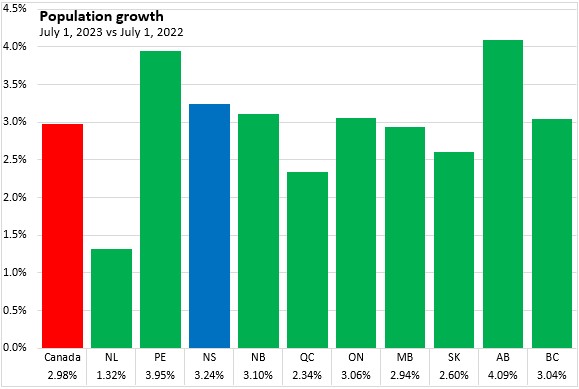
The July 1, 2022 to July 1, 2023 population increase was 33,249 - by far largest July 1 to July 1 population growth in the modern data series (that started in 1971) as well as in historical records spanning 1921-1971.
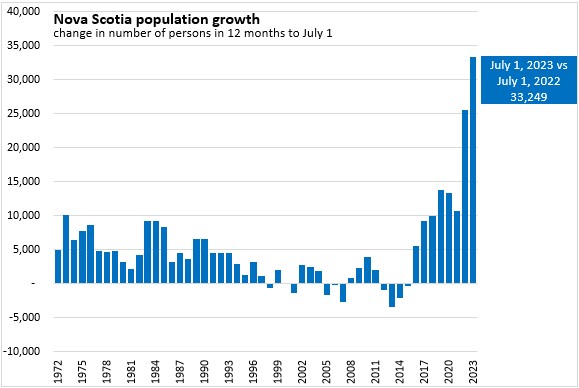
In percentage terms, Nova Scotia's growth of 3.24% was the fastest growth in records dating back over a century.
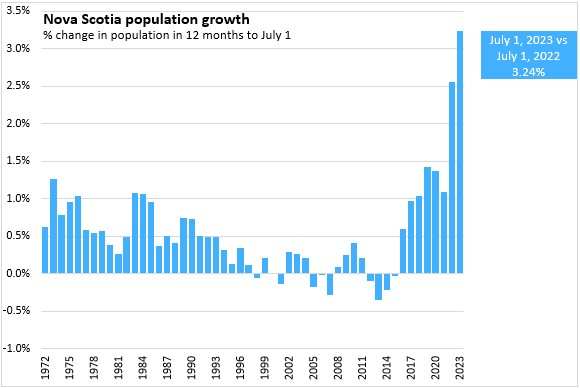
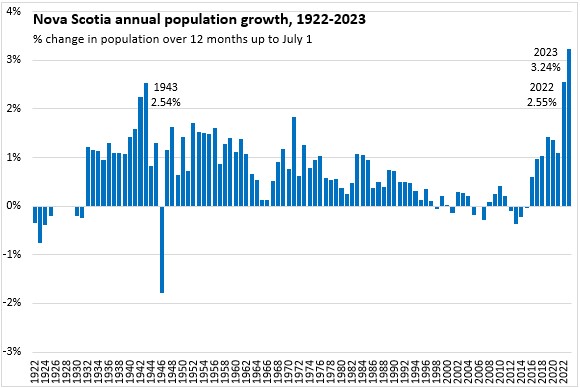
Nova Scotia's extraordinary population growth was attributable to a sharp increase in net non-permanent residents (+15,518) as well as continued immigration (12,203) as well as net interprovincial migration (+8,526, reflecting 24,226 in-migrants and 15,700 out-migrants). There were a small number of emigrants leaving Nova Scotia for another country (482). Although the pace of births increased to 8,122 this was offset by a rising number of deaths (10,738).
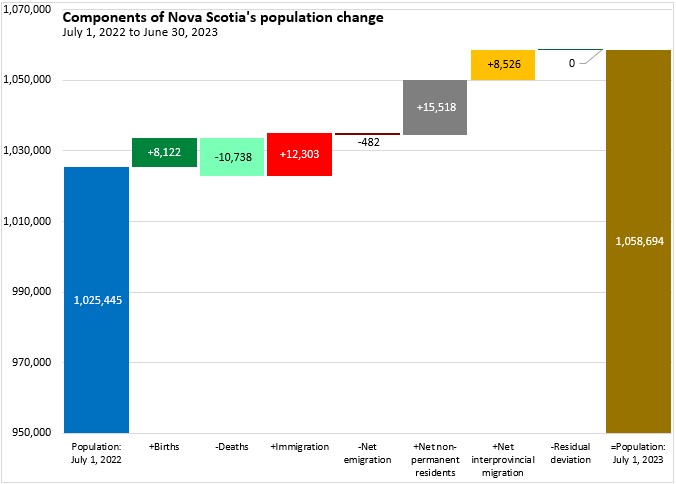
When measured as a percentage of the population on July 1, 2022, Nova Scotia reported less population growth as a result of births and steeper population decline as a result of deaths. Although Canada's national population was still increasing because of natural population change (births less deaths), deaths outnumbered births in all Atlantic provinces as well as in British Columbia.
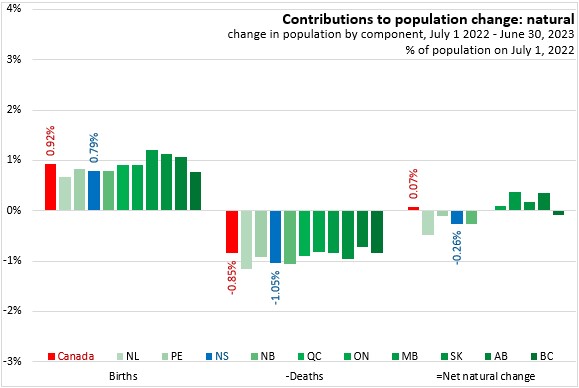
International migration is the main contributor to Canada's population growth. Measured as a share of the July 1, 2022 population immigration contributed about the same amount to Nova Scotia's population growth as it contributed to national population growth. Saskatchewan reported the largest contribution to population gain from immigration while Québec reported the least contribution from immigration.
Net emigration (including returning emigrants) was a comparatively small drain on the population for all provinces.
All provinces reported a substantial contribution to population growth as a result of net change in non-permanent residents, led by Ontario and British Columbia. The contribution of net non-permanent residents to population change was slower in Nova Scotia than at the national level. Newfoundland and Labrador reported the smallest contribution to population change from non-permanent residents.
Considering immigration, net emigration and non-permanent residents, all provinces reported net international population gains, led by Manitoba, Ontario and British Columbia.
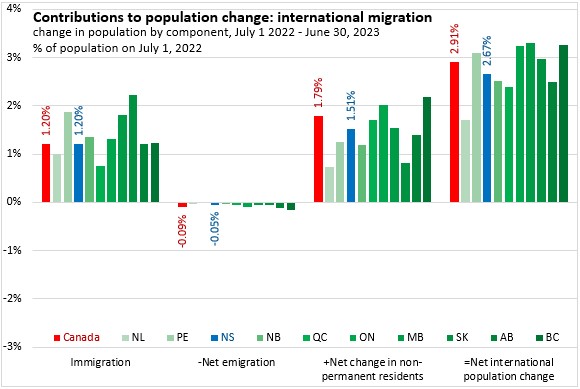
Nova Scotia reported the second largest contribution to population change as a result of interprovincial in-migration (measured as a percentage of July 1, 2022 population). Out-migration to other provinces was a larger drain on Nova Scotia's population than the national average. Alberta and the Maritime provinces reported the strongest contributions to population growth from net interprovincial migration. Manitoba and Saskatchewan reported the largest percentage declines as a result of net interprovincial migration.
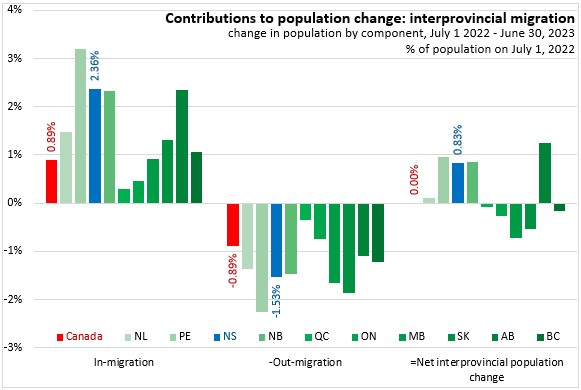
Natural population change (births less deaths) continued to put downward pressure on Nova Scotia's population. From July 1, 2022 to July 1, 2023 there were 8,122 births and 10,738 deaths, resulting in a net natural population change of -2,616 over this period.
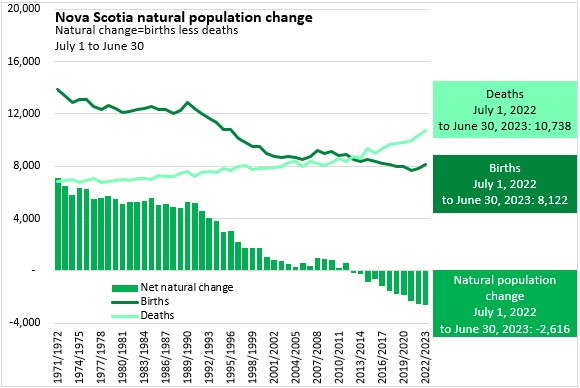
From July 1, 2022 to July 1, 2023, Nova Scotia reported 12,303 immigrants coming to the province. This was down slightly from the record immigration reported in the previous year.
Net emigration resulted in 482 persons moving from the province to another country between July 1, 2022 and July 1, 2023 (than returned from prior emigration).
The change in non-permanent residents (which includes students and temporary foreign workers) was a gain of 15,518 persons, by far the largest increase in non-permanent residents in Nova Scotia's modern demographic records.
Accounting for the decline resulting from net emigration and the gains from immigrants and non-permanent residents, the net international population change for Nova Scotia was +27,339 from July 1, 2022 to July 1, 2023 - a substantial rise over the +17,150 reported in the previous 12 months.

Although Nova Scotia's immigration levels remain near their all-time highs, they have been eclipsed by the rapid rise in the number of non-permanent residents.
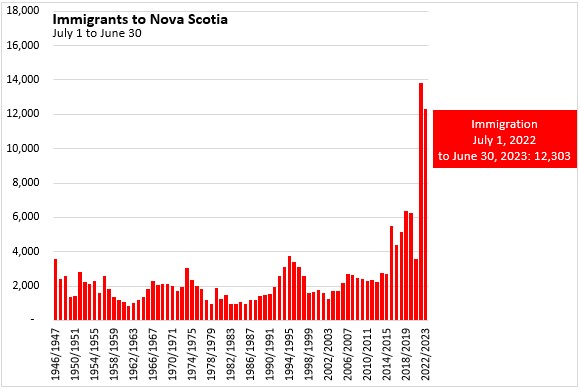

The period from July 1, 2022 to July 1, 2023 marked the eighth consecutive year of positive net interprovincial migration to Nova Scotia. Although lower than in the last two years, the net increase of 8,526 in interprovincial movers was the third largest amount for comparable periods dating back to 1961. The number of in-migrants to Nova Scotia from other provinces contracted to 24,226 while the number of out-migrants from Nova Scotia increased to 15,700.
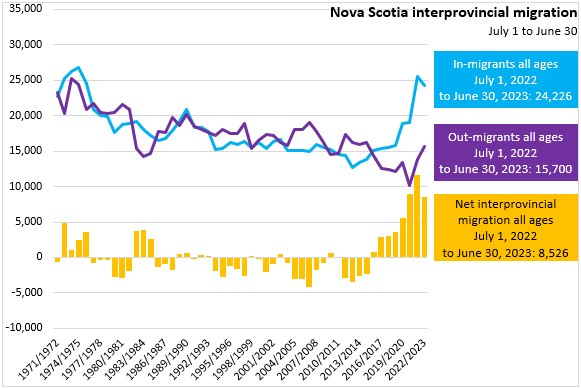
There was net positive interprovincial migration across much of the age distribution. Net interprovincial migration of children (aged 0-14) contributed 1,267 to Nova Scotia's population from July 1, 2022 to July 1, 2023 as in-migration of 3,936 was larger than out-migration of 2,669.

Interprovincial migration of those agesd 15-34 was positive at +2,897 from July 1, 2022 to July 1, 2023. However, increases for in-migration (10,115) were outpaced by the rise in out-migration (7,218). Canadians in these age cohorts are notably more mobile than their counterparts in other age cohorts.
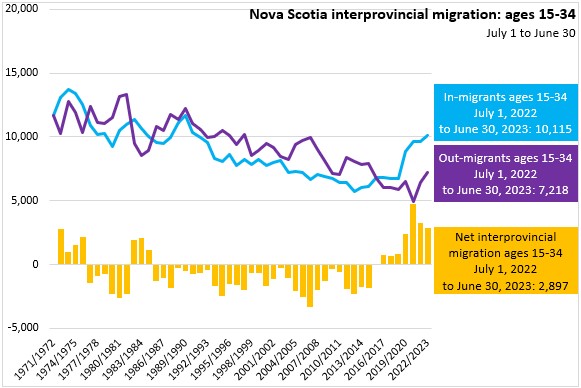
Net migration of those aged 35-49 was also positive at +1,578 as in-migration fell to 4,513 while out-migration rose to 2,935.

The pace of net migration among persons aged 50-64 slowed to 1,985 as lower in-migration (3,764) still exceeded out-migration at 1,779.
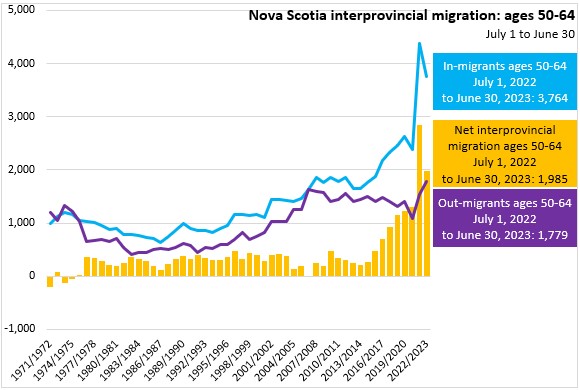
Prior to July 1, 2022, there was a substantial increase in net migration of seniors aged 65 and older to Nova Scotia, largely through rising in-migration. From July 1, 2022 to July 1, 2023, net migration of those aged 65 and older into Nova Scotia slowed to 799 persons reflecting a contraction in in-migration to 1,898 as well as a rise in out-migration to 1,099.
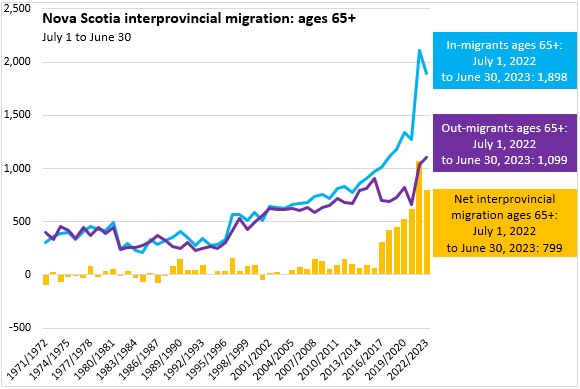
Volatility in Nova Scotia's net migration is often driven by those aged 15-34, who exhibit greater mobility. However, in the last few years, there has been a rise in net migration from all age cohorts, peaking in the period from July 1, 2021 to July 1, 2022.
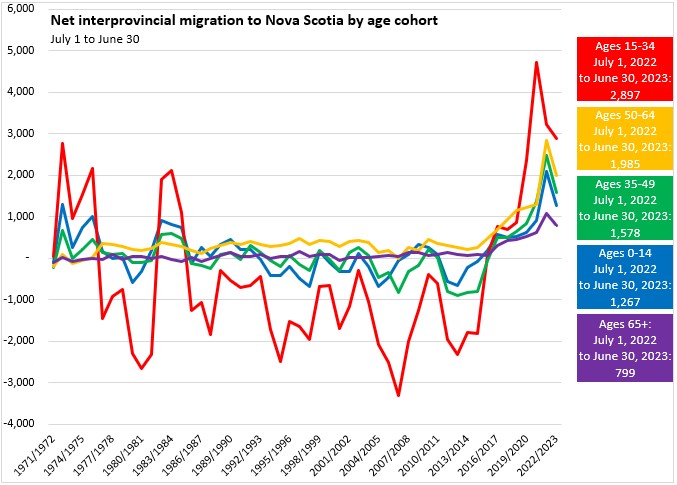
By source and destination, the largest sources of net interprovincial migration to Nova Scotia were Ontario (+7,940) and British Columbia (+1,256).
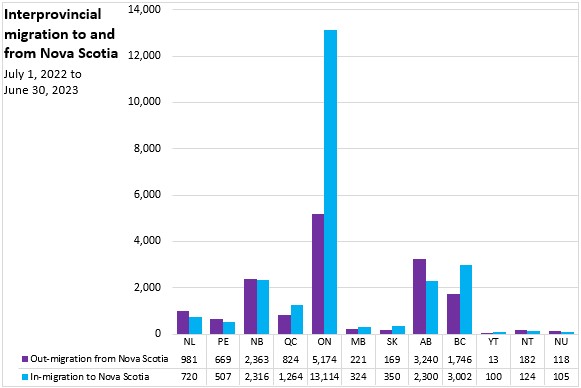
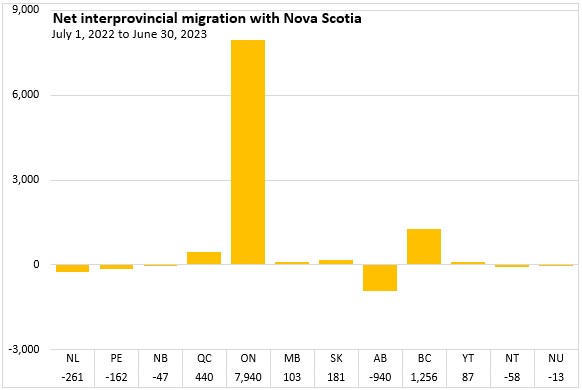
There has been a sharp rise in in-migration to Nova Scotia from Ontario over the past decade. More recently, there has also been an increase in in-migration to Nova Scotia from British Columbia. In-migration from Alberta to Nova Scotia increased substantially from July 1, 2021 to July 1, 2022, but has returned to a declining trend.
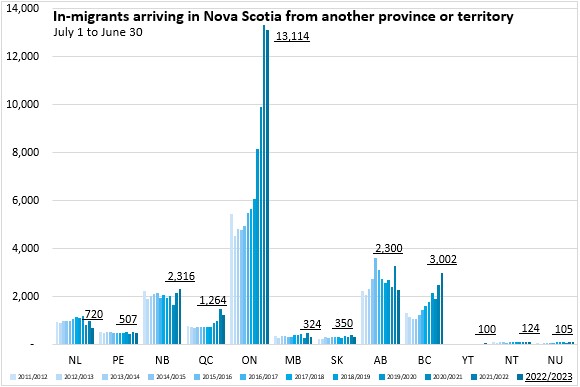
From July 1, 2022 to July 1, 2023, Ontario continued to be the largest destination for out-migrants leaving Nova Scotia. There were notable increases in out-migration from Nova Scotia to Alberta, British Columbia, New Brunswick and Newfoundland and Labrador.
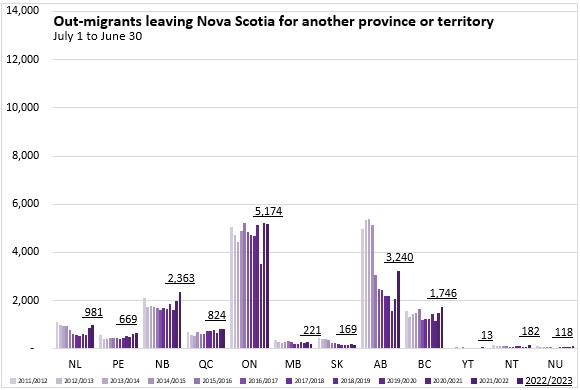
Nova Scotia reported negative net interprovincial migration with all other Atlantic Provinces as well as with Alberta, Nunavut and the Northwest Territories. These were more than offset by positive net interprovincial migration to Nova Scotia from Ontario, British Columbia, Québec, Saskatchewan, Manitoba and the Yukon territory.
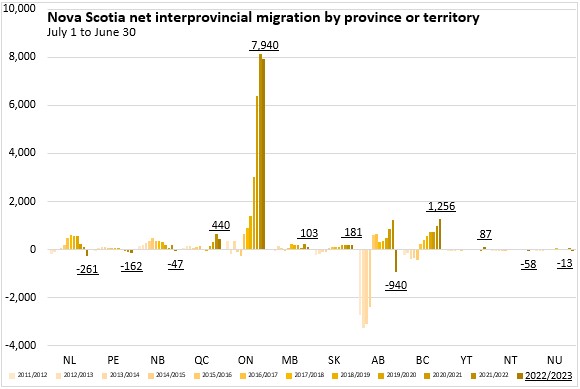
With significant increases in immigration and interprovincial in-migration of younger cohorts, Nova Scotia's median age has contracted substantially - falling from 44.5 years as of July 1, 2022 to 43.8 years as of July 1, 2023. This was still the third highest median age among provinces after Newfoundland and Labrador and New Brunswick. The national median age was 40.6 years with the lowest median age in Manitoba (37.5 years).

Nova Scotia's median age has not increased since 2018.
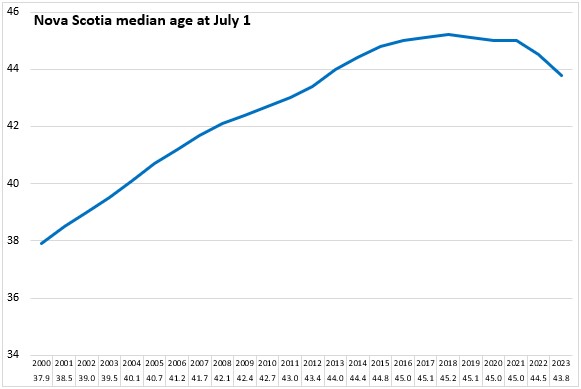
Nova Scotia's population last experienced an extended decline in median age during the late 1950s and early 1960s following elevated births from the baby boom.
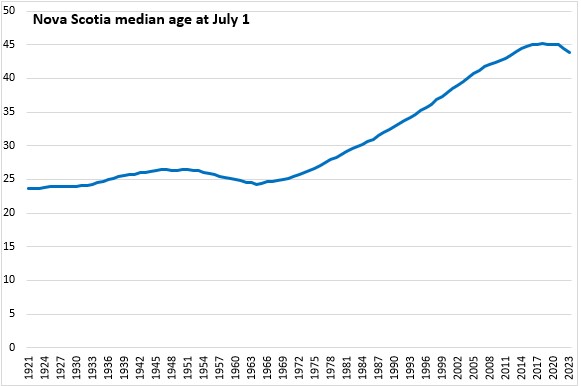
Immigration and net interprovincial migration have contributed to a reversal in declining populations of Nova Scotia's younger cohorts, particularly for those aged 0-17, 15-34 and 35-49.

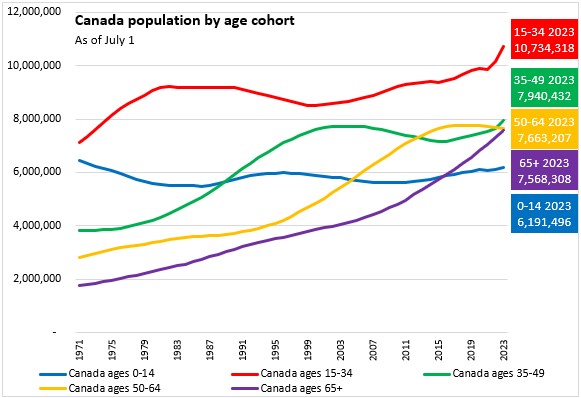
Despite a revival of growth among younger population cohorts in Nova Scotia, the population pyramid shows an older population than the national age distribution.
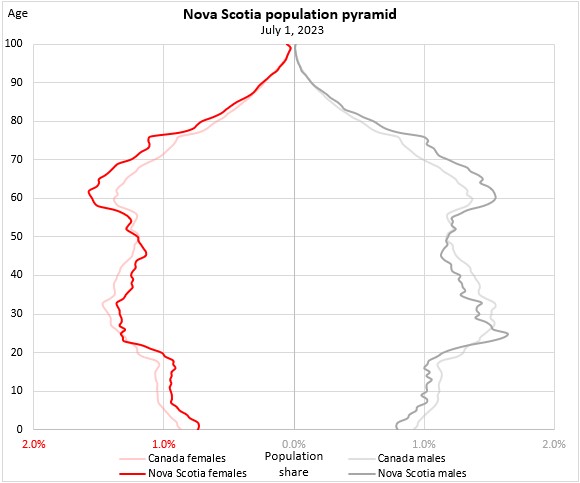
Source: Statistics Canada. Table 17-10-0005-01 Population estimates on July 1st, by age and sex, Table 17-10-0008-01 Estimates of the components of demographic growth, annual, Table 17-10-0014-01 Estimates of the components of international migration, by age and sex, annual, Table 17-10-0015-01 Estimates of the components of interprovincial migration, by age and sex, annual, Table 17-10-0022-01 Estimates of interprovincial migrants by province or territory of origin and destination, annual, Table 17-10-0009-01 Population estimates, quarterly, Table 17-10-0040-01 Estimates of the components of international migration, quarterly, Table 17-10-0020-01 Estimates of the components of interprovincial migration, quarterly
<--- Return to Archive